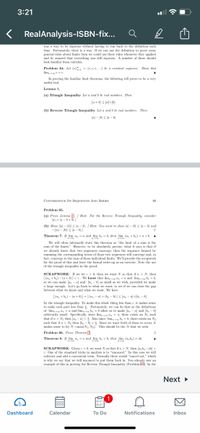
Advanced Engineering Mathematics
10th Edition
ISBN: 9780470458365
Author: Erwin Kreyszig
Publisher: Wiley, John & Sons, Incorporated
expand_more
expand_more
format_list_bulleted
Question
thumb_up100%
#64

Transcribed Image Text:3:21
RealAnalysis-ISBN-fix...
was a way to be rigorous without having to run back to the definition each
time. Fortunately, there is a way. If we can use the definition to prove some
general rules about limits then we could use these rules whenever they applied
and be assured that everything was still rigorous. A number of these should
look familiar from calculus.
Problem 64. Let (c) - (c, c, e,...) be a constant sequence. Show that
lim e=e.
In proving the familiar limit theorems, the following will prove to be a very
useful tool.
Lemma 1.
(a) Triangle Inequality Let a and b be real numbers. Then
la +6 s lal+l6|-
(b) Reverse Triangle Inequality Let a and b be real numbers. Then
Ja| - 16 S la - M
CONVERGENCE OF SEQUENCES AND SERIES
80
Problem 65.
(a) Prove Lemma 0/ Hint: For the Reverse Triangle Inequality, consider
Jal - la - b+
(b) Show |la| - |6|| s la - 4. / Hint: You want to show lal - 16| s la - b| and
/'l9 - | 5 (l9l – l|)-
Theorem 7. If lim a, =a and lim b, - 6, then lim (a, +6) = a+b. A
We will often informally state this theorem as "the limit of a sum is the
sum of the limits." However, to be absolutely precise, what it says is that if
we already know that two sequences converge, then the sequence formed by
summing the corresponding terms of those two sequences will converge and, in
fact, converge to the sum of those individual limits. We'll provide the scrapwork
for the proof of this and leave the formal write-up as an exercise. Note the use
of the triangle inequality in the proof.
SCRAPWORK: If we let e > 0, then we want N so that if n > N, then
|(a, + 6) - (a + b)<e. We know that lim n =a and lim, - 6,
so we can make Jan - al and b, - 6| as small as we wish, provided we make
n large enough. Let's go back to what we want, to see if we can ckose the gap
between what we know and what we want. We have
|(a, + b) – (a + 6) |-|(a, - a) + (b, - b) |s la, - a|+|b, - b|
by the triangle inequality. To make this whole thing less than e, it makes sense
to make each part less than 5. Fortunately, we can do that as the definitions
of lim, d = a and lim,x b. = b allow us to make a, - a and b. - 6
arbitrarily small. Specifically, since lim,x n = a, there exists an Ni stuch
that if n> N, then Ja, -al <. Also since lim, b, = 6, there exists an Ng
such that if n> Na then b, - 6 <5. Since we want both of these to occur, it
makes sense to let N max(N1, Na). This should be the N that we seek.
Problem 66. Prove Theorem 2
Theorem 8. If lim a, =a and lim , - 6, then lim (a,b,) = ab.
SCRAPWORK: Given e>0, we want N so that if n> N, then Ja,b-ab <
e. One of the standard tricks in analysis is to "uncancel." In this case we will
subtract and add a convenient term. Normally these would "cancel out," which
is why we say that we will uncancel to put them back in. You already saw an
example of this in proving the Reverse Triangle Inequality (Problem 6). In the
Next
1
Dashboard
Calendar
To Do
Notifications
Inbox
Expert Solution
arrow_forward
Step 1
To prove our required result, we used the epsilon-delta definition of convergent.
Step by stepSolved in 2 steps with 1 images

Knowledge Booster
Similar questions
arrow_back_ios
arrow_forward_ios
Recommended textbooks for you
 Advanced Engineering MathematicsAdvanced MathISBN:9780470458365Author:Erwin KreyszigPublisher:Wiley, John & Sons, Incorporated
Advanced Engineering MathematicsAdvanced MathISBN:9780470458365Author:Erwin KreyszigPublisher:Wiley, John & Sons, Incorporated Numerical Methods for EngineersAdvanced MathISBN:9780073397924Author:Steven C. Chapra Dr., Raymond P. CanalePublisher:McGraw-Hill Education
Numerical Methods for EngineersAdvanced MathISBN:9780073397924Author:Steven C. Chapra Dr., Raymond P. CanalePublisher:McGraw-Hill Education Introductory Mathematics for Engineering Applicat...Advanced MathISBN:9781118141809Author:Nathan KlingbeilPublisher:WILEY
Introductory Mathematics for Engineering Applicat...Advanced MathISBN:9781118141809Author:Nathan KlingbeilPublisher:WILEY Mathematics For Machine TechnologyAdvanced MathISBN:9781337798310Author:Peterson, John.Publisher:Cengage Learning,
Mathematics For Machine TechnologyAdvanced MathISBN:9781337798310Author:Peterson, John.Publisher:Cengage Learning,


Advanced Engineering Mathematics
Advanced Math
ISBN:9780470458365
Author:Erwin Kreyszig
Publisher:Wiley, John & Sons, Incorporated

Numerical Methods for Engineers
Advanced Math
ISBN:9780073397924
Author:Steven C. Chapra Dr., Raymond P. Canale
Publisher:McGraw-Hill Education

Introductory Mathematics for Engineering Applicat...
Advanced Math
ISBN:9781118141809
Author:Nathan Klingbeil
Publisher:WILEY

Mathematics For Machine Technology
Advanced Math
ISBN:9781337798310
Author:Peterson, John.
Publisher:Cengage Learning,

